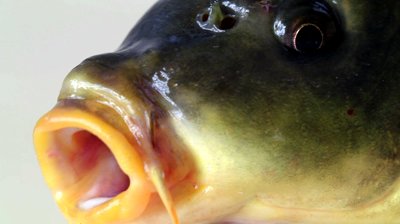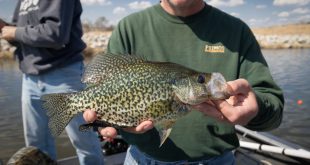We are having some fun with “Carp Week” on our Game & Parks FaceBook page this week. You are not going to find carp near the top of any of my favorite fish lists, but I have said that all of the fish that swim our waters are unique and should be appreciated for their uniqueness. No, carp are not going to be the most popular sport fish in Nebraska, but they can be a lot of fun to catch, they are a worthy quarry for any angler, even the best anglers, and they can be good on the table too. Being the fisheries biologist that I am, my approach to catching, and appreciating, any fish is to understand them, know more about them. So, let me recycle some material from previous blog posts and give you some carp knowledge that I am betting many of you did not know before. . . .
Brains
I will always tell you that the brain inside the head of the fish you pursue, even the biggest fish, even common carp, is about the size of the end of your little finger. The fish we pursue ain’t no rocket surgeons. But, common carp are probably the smartest fish that swim in our waters. If you are fishing waters where common carp are not pursued, not targeted by anglers, you will probably find they are relatively easy to catch. But if you put some activity, and especially some fishing activity targeted at common carp on that body of water, the carp will become a lot harder to catch. Google “carp fishing” and you will find literally volumes of information on baits and rigs and things you never dreamt about. Much of that has been developed in Europe where common carp have been caught & released for years, even centuries. Those sophisticated tactics will work here in good old Nebraska, you betcha, but you can probably start simple with a plain ole hook and sinker and then work up from there.
“You are what you eat.”
Common carp are omnivores–that means they eat a lot of things. Primarily they feed by sucking, literally vacuuming, stuff off the bottom. They often feed by rooting around in bottom sediments and then sorting out a variety of edible vegetable and animal materials from those bottom sediments (and that feeding activity is the big reason they are so detrimental to water quality and aquatic habitat). I have seen common carp on the Missouri River feeding on live, young-of-the-year gizzard shad that were pinned by currents right up against the shoreline (every fish in the river was coming up to suck gizzard shad off the surface that morning, gar, drum, catfish, white bass, walleye, carp, you name it). Most of us have stories of common carp taking artificial lures of some type, BUT most of the time you will want to imitate some small aquatic insect to catch common carp–a tactic employed by many fly-anglers. OR, more likely, you will present some type of natural or prepared bait on or near the bottom. Nightcrawlers or worms have accounted for a lot of common carp, and so have a variety of other baits, especially corn.
Common carp have a very good sense of smell and taste; the barbels that carp have in each corner of the mouth are one way they sense scents and flavors. Hard-core carp anglers will have a favorite dough bait recipe or may fish with corn or some other bait, but many of them will “kick their baits up a notch” by adding a variety of flavors. Common carp appear to have a sweet tooth; they love sweet, fruity scents and flavors (if you find a mulberry tree overhanging and dropping berries into the water–fish it! Common carp and other species of fish like channel catfish L-O-V-E mulberries). Consider adding a Jell-O mix to your dough bait or corn, or Vanilla extract. If you find a carp specialty shop on the internet they will have a variety interesting scents, baits and even amino acids that can be added to carp baits. Common carp also like it HOT! Yep, add a bottle of Tabasco sauce to your corn.
Now I doubt that the carp actually believe those scents and tastes are food for them, but there is no doubt those scents and flavors will attract and catch common carp. If you are catching fish, if it is working, why ask “why”? However, keep in mind that over time the carp may become “conditioned” to those exotic scents and tastes and if they have been “burned” on those baits you might have to switch it up. If one bait quits working, you might have to eat it while coming up with something different for the carp!
Teeth
Everyone knows that sharks have teeth, but so do carp! I mentioned earlier this week that common carp are actually members of the minnow family and all members of that family can actually be identified by their teeth! Nope, you ain’t gonna find those teeth anywhere near their lips. Instead they have teeth much like molars located at the back of their throat. They are called pharyngeal teeth.
When common carp decide they want to eat some food item that they have sucked up, they shift it to the back of their throats where it is crushed between those pharyngeal teeth and a hard leathery patch at the roof of their throat. That gives you some ideas about the feeding behavior of carp and some clues about catching, especially hooking carp. If you find some hard-core carp fishing information you will likely find references to “hair rigs”.
That is what a hair rig looks like and it works because when a carp moves the bait, the corn in that illustration, to the back of their throat, the hook is positioned right near the “lips” where an angler will get an excellent hook set.
If you want to get a little more sophisticated and technical with your carp fishing presentations, here is a good “how to” video on tying a hair rig.
By the way, you can go on-line and order the specialized carp fishing gear and even baits mentioned in that video, or you can do like I have done and go to the basement and adapt/make your own.
Lips
Speaking of lips. Carp have sensitive lips and the barbels are also very sensitive “touch” organs. They smell and taste for food items but they also feel with their lips and barbels. You will find that using soft braided lines for leaders and hair rigs will result in more hook-ups because that feels more natural on their lips than a hard monofilament or fluorocarbon line.

 Nebraskaland Magazine
Nebraskaland Magazine




